| Listing 1 - 8 of 8 |
Sort by
|
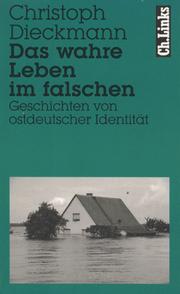
ISBN: 3861531682 Year: 2000 Publisher: Berlin Links
Abstract | Keywords | Export | Availability | Bookmark
 Loading...
Loading...Choose an application
- Reference Manager
- EndNote
- RefWorks (Direct export to RefWorks)
National characteristics, East German --- Nationalism --- Political culture --- Socialism --- Psychological aspects --- Germany (East) --- Intellectual life.
Book
ISBN: 9783492053655 Year: 2009 Publisher: München Piper
Abstract | Keywords | Export | Availability | Bookmark
 Loading...
Loading...Choose an application
- Reference Manager
- EndNote
- RefWorks (Direct export to RefWorks)
Group identity --- National characteristics, East German --- National characteristics, West German --- History --- Germany (East) --- Germany --- Social life and customs.
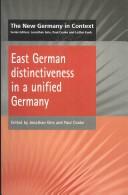
ISBN: 1282452304 9786612452307 0567536068 9780567536068 1902459172 9781902459172 9781282452305 6612452307 Year: 2002 Publisher: Birmingham University of Birmingham Press
Abstract | Keywords | Export | Availability | Bookmark
 Loading...
Loading...Choose an application
- Reference Manager
- EndNote
- RefWorks (Direct export to RefWorks)
Introduction * The Nature of Research * The 'Nuts and Bolts' of Research * Getting Started in Research * The Building Blocks of Research * Introducing the Key Research Paradigms * The Types and Uses of Theory in Research * Introducing Research Methods * Academic Standards, Plagiarism and Ethics in Research * Conclusion: Summary of Key Points * Appendix 1: Stages of Research * Appendix 2: Glossary of Terms * Bibliography.
National characteristics, East German. --- Political culture --- Civil society --- Social contract --- East German national characteristics --- Germany (East) --- Germany --- Intellectual life. --- Politics and government. --- Politics and government
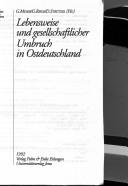
ISBN: 3789606030 Year: 1992 Volume: 3 Publisher: Berlin ; München : Palm & Enke,
Abstract | Keywords | Export | Availability | Bookmark
 Loading...
Loading...Choose an application
- Reference Manager
- EndNote
- RefWorks (Direct export to RefWorks)
National characteristics, East German --- East German national characteristics --- Germany (East) --- -Germany (East) --- -Social conditions --- Politics and government --- -Politics and government --- National characteristics, East German. --- Politics and government. --- Social conditions. --- Social conditions --- Social life and customs --- Economic conditions --- Allemagne --- Conditions sociales --- 20e siecle
Book
ISBN: 9780521111775 0521111773 Year: 2009 Volume: *29 Publisher: Cambridge Cambridge University Press
Abstract | Keywords | Export | Availability | Bookmark
 Loading...
Loading...Choose an application
- Reference Manager
- EndNote
- RefWorks (Direct export to RefWorks)
"Twenty years after the collapse of the German Democratic Republic, historians still struggle to explain how an apparently stable state imploded with such vehemence. This is the first book to show how 'national' identity was invented in the GDR and how citizens engaged with it. Jan Palmowski argues that it was hard for individuals to identify with the GDR amid the threat of Stasi informants and with the accelerating urban and environmental decay of the 1970s and 1980s. Since socialism contradicted its own ideals of community, identity and environmental care, citizens developed rival meanings of nationhood and identities and learned to mask their growing distance from socialism beneath regular public assertions of socialist belonging. This stabilized the party's rule until 1989. However, when the revolution came, the alternative identifications citizens had developed for decades allowed them to abandon their 'nation', the GDR, with remarkable ease"--Provided by publisher "This study explores the significance and the meanings of nation, homeland and patriotism under the conditions of socialism in the German Democratic Republic (GDR). The GDR hardly constitutes a 'typical' socialist state. A central pillar to the Soviet domination of Eastern Europe and a frontline state in the Cold War, the GDR remained tightly under Soviet control until 1989. What made the GDR unique within the socialist bloc was the absence of a distinctive nationhood, which was constantly challenged by the larger and more prosperous part of Germany, the Federal Republic of Germany (FRG). For this reason, those scholars who have considered the issue have argued that in the GDR, nationalism played next to no role 'as movement, as political idea, and as popular sentiment' before 1989. The idea of the nation, such as it existed, was closely tied to the promise of consumerism in the FRG - 'DM Nationalismus', as Jurgen Habermas called it. National identity appeared to be of little consequence in assessing the history of the GDR and its collapse. Even German reunification 'was not so much a nationalist idea as a route for East Germans to an imagined world of prosperity and freedom'"--Provided by publisher
History of Germany and Austria --- anno 1900-1999 --- Germany (GDR) --- Nationalism --- Nationalism and socialism --- Political culture --- National characteristics, East German --- Nationalisme --- Nationalisme et socialisme --- Culture politique --- Allemands de l'Est --- Allemagne (Est) --- Sozialistische Einheitspartei Deutschlands --- Germany (East) --- Politics and government --- Social conditions --- Politique et gouvernement --- Conditions sociales
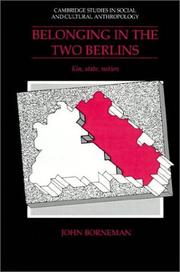
ISBN: 0521427150 0521415896 0511607717 Year: 1992 Publisher: Cambridge : Cambridge University Press,
Abstract | Keywords | Export | Availability | Bookmark
 Loading...
Loading...Choose an application
- Reference Manager
- EndNote
- RefWorks (Direct export to RefWorks)
Belonging in the two Berlins is an ethnographic investigation into the meaning of German selfhood during the Cold War. Taking the practices of everyday life in the divided Berlin as his point of departure, Borneman shows how ideas of kin, state, and nation were constructed through processes of mirror-imaging and misrecognition. Using linguistics and narrative analysis, he compares the autobiographies of two generations of Berlins residents with the official version of the lifecourse prescribed by the two German states. He examines the relation of the dual political structure to everyday life, the way in which the two states legally regulated the lifecourse in order to define the particular categories of self which signify Germanness, and how citizens experientially appropriated the frameworks provided by these states. Living in the two Berlins constantly compelled residents to define themselves in opposition to their other half. Borneman argues that this resulted in a de facto divided Germany with two distinct nations and peoples. The formation of German subjectivity since World War II is unique in that the distinctive features for belonging - for being at home - to one side exclude the other. Indeed, these divisions inscribed by the Cold War account for many of the problems in forging a new cultural unity.
Ethnology --- Berlin (Germany) --- Kinship --- Social conditions --- Economic conditions --- Social life and customs --- Ethnology - Germany - Berlin. --- Kinship - Germany - Berlin. --- National characteristics, West German. --- National characteristics, East German. --- Berlin (Germany) - Social conditions. --- Berlin (Germany) - Economic conditions. --- Berlin (Germany) - Social life and customs. --- Social Sciences --- Anthropology --- Social conditions. --- Economic conditions. --- Social life and customs. --- East German national characteristics --- West German national characteristics --- Clans --- Consanguinity --- Families --- Kin recognition --- Cultural anthropology --- Ethnography --- Races of man --- Social anthropology --- Human beings
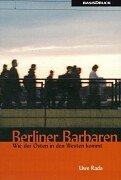
ISBN: 3861631156 Year: 2001 Publisher: Berlin : BasisDruck,
Abstract | Keywords | Export | Availability | Bookmark
 Loading...
Loading...Choose an application
- Reference Manager
- EndNote
- RefWorks (Direct export to RefWorks)
National characteristics, East German --- National characteristics, East European --- Allemands de l'Est --- Européens de l'Est --- Berlin (Germany) --- Berlin (Germany) --- Germany (East) --- Europe, Eastern --- Berlin (Germany) --- Berlin (Allemagne) --- Berlin (Allemagne) --- Allemagne (Est) --- Europe de l'Est --- Berlin (Allemagne) --- Ethnic relations --- Emigration and immigration. --- Emigration and immigration --- Emigration and immigration. --- Social conditions --- Relations interethniques --- Emigration et immigration --- Emigration et immigration --- Emigration et immigration --- Conditions sociales
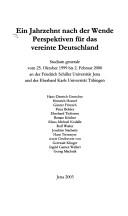
ISBN: 3932218108 Year: 2003 Volume: 11 Publisher: Jena Friedrich-Schiller-Universität
Abstract | Keywords | Export | Availability | Bookmark
 Loading...
Loading...Choose an application
- Reference Manager
- EndNote
- RefWorks (Direct export to RefWorks)
National characteristics, East German --- East German national characteristics --- Germany (East) --- -Germany --- Germany --- Economic integration --- Economic integration. --- Politics and government --- -National characteristics, East German --- Weimar Republic --- Germanii︠a︡ --- Германия --- BRD --- FRN --- Jirmānīya --- جرمانيا --- Nimechchyna --- Gjermani --- Federalʹna Respublika Nimechchyny --- Veĭmarskai︠a︡ Respublika --- Ashkenaz --- Germanyah --- Bundesrepublik Deutschland --- Federal Republic of Germany --- Deutschland --- Repoblika Federalin'i Alemana --- República Federal de Alemania --- Alemania --- República de Alemania --- Bu̇gd Naĭramdakh German Uls --- Kholboony Bu̇gd Naĭramdakh German Uls --- KhBNGU --- ХБНГУ --- German Uls --- Germania --- Republika Federal Alemmana --- Deutsches Reich --- Grossdeutsches Reich --- Weimarer Republik --- Vācijā --- Germany (Territory under Allied occupation, 1945-1955) --- Germany (Territory under Allied occupation, 1945-1955 : British Zone) --- Germany (Territory under Allied occupation, 1945-1955 : French Zone) --- Germany (Territory under Allied occupation, 1945-1955 : Russian Zone) --- Germany (Territory under Allied occupation, 1945-1955 : U.S. Zone) --- Germany (West) --- Holy Roman Empire --- Germany (Democratic Republic, 1949- ) --- Deutsche Demokratische Republik --- Tyske demokratiske republik --- Democratic German Republic --- German Democratic Republic --- East German Democratic Republic --- East Germany (Democratic Republic) --- DDR --- Germanskai︠a︡ Demokraticheskai︠a︡ Respublika --- Nĕmecká demokratická republika --- NDR --- Nimet︠s︡ʹka Demokratychna Respublika --- GDR --- Niemiecka Republika Demokratyczna --- NRD --- Német Demokratikus Köztársaság --- NDK --- Tyska demokratiska republiken --- Östtyskland --- Republica Democrată Germană --- Repubblica democratica tedesca --- Germany (Democratic Republic) --- D.D.R. --- N.D.R. --- G.D.R. --- N.R.D. --- N.D.K. --- República Democrática Alemana --- RDA --- R.D.A. --- Ostdeutschland --- Eastern Germany --- Cộng hòa dân chủ Đức --- ドイツ --- Doitsu --- ドイツ連邦共和国 --- Doitsu Renpō Kyōwakoku --- ドイツ レンポウ キョウワコク --- Deguo --- 德国 --- Gėrman --- Герман Улс
| Listing 1 - 8 of 8 |
Sort by
|

 Search
Search Feedback
Feedback About UniCat
About UniCat  Help
Help News
News